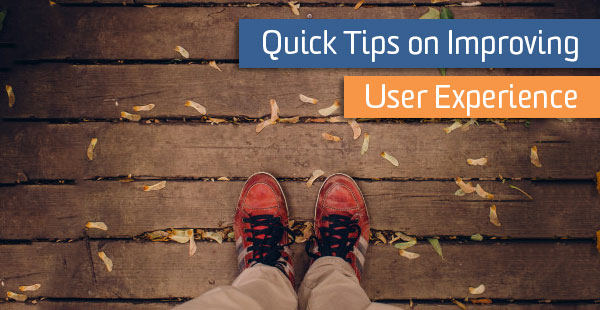Quick Tips On Improving User Experience

User experience has become more and more important in the 21st century.
We live in a digitally focused world. Activity occurs constantly. And it occurs across all device types. Way back when, an optimal user experience meant your landing page loaded. Then it became responsive design. Now, it’s even more involved. An optimal user experience means a customer-oriented experience. What the consumer wants, you need to make sure he or she gets.
Here are some things to know right now if you’re trying to enhance your website visitors’ experiences.
Tip 1: Keep It Simple!
Simplicity is key. Make it simple for a user to navigate, to search on your website, to read your content! Make an effort to put pages where users would look for them, write short to-the-point sentences and paragraphs, and be sure to use headlines and bulleted lists where possible. Allow visitors to get where they want to go quickly and easily.
If you need some inspiration, check out these websites that breathe simplicity: this one, another, and another… last one.
And this principle isn’t just limited to user experience! The KISS principle has been around for a long time – Keep it Simple, Stupid. You can’t go wrong.
Tip 2: Navigation Should Be Easy

Make it easy for your customers to find things on your website, whether that’s a product, blog, pricing pages, the contact us form, etc. Help your website help your users by ensuring ease of use in navigation. Keep navigation consistent across pages and organize into a hierarchical structure that makes sense.
Good rule of thumb – if it’s hard for YOU to find it, it will be hard for your consumers to find it.
Tip 3: Speed up Page Load Times
Page load time is important. Did you know that 47% of users expect a page to load under 2 seconds.
U n d e r 2 S e c o n d s.
The time it took you to read that, your website should have loaded. If you want to check your page load time, Google has a nifty tool that will measure page speed and provide suggestions for improvement. Google Analytics can help with this as well!
Tip 4: Put Yourself in Their Shoes

Assess your user experience as if you were the consumer. Perhaps hold a focus group or create a ‘consumer persona’. What does the consumer want to see? What questions can you answer for them with your content? How can you improve the content they see or the flow of information to better serve them?
Tip 5: Test across Browsers and Devices
Test your website across all browsers and devices types for compatibility issues. What shows up in Chrome may look very different on Safari. Make sure your website is usable regardless of where a user accesses it. And, if you haven’t done so already – make sure your website is optimized for mobile. There are several tools (some are free) that you can use to test – such as this one and this one.
Tip 6: Fix any Broken Links or 404 Errors
Send users where you intend for them to go. Fix any issues or roadblocks that would prevent users from getting there. Here’s an online tool that will help you find broken links on your website. We’ve also got some tips to handle your 404 errors as well!
Before you go, here’s a neat 7-minute test that you can take to score your website’s user experience, created by our own Andrew Garberson.
So there it is. Take those quick tips and run with them. Cheers to keeping those visitors on site!


